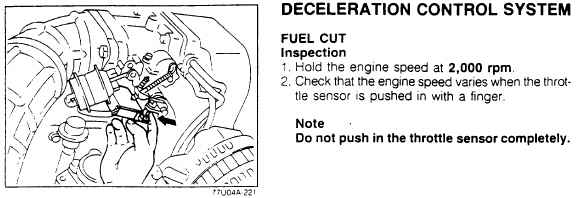DECELERATION CONTROL SYSTEM
Upon deceleration, the supply of air to the engine is reduced (due to the throttle plates closing). If the fuel supply was to remain unchanged, the air fuel mixture would become rich. This is not desired since a rich fuel mixture increases gas consumption and harmful emissions. It also causes backfiring in the exhaust because not all the fuel is burnt in the engine, as it should be in normal conditions. There are two ways to counter this momentary rich condition: cut the fuel supply and/or inject extra air into the intake manifold.
FUEL CUT
When the throttle plates close, the throttle position sensor (TPS) signals to the engine control unit (ECU) a deceleration condition. The ECU then cuts (some) fuel to the engine. Because the volume of air entering the engine is greatly reduced as the throttle plates close, the ECU reacts by cutting the fuel supply to re-establish an acceptable air/fuel ratio.

This above shows the factory service manual (FSM) procedure to test for proper fuel cut operation. When the TPS is pushed in while keeping the throttle plates at same angle, the ECU has a priori no reason to cut the fuel supply since the volume of air entering the engine and the engine speed (rpm) are unchanged (no change in load). This is of course unless the ECU recognizes a deceleration condition by looking at the TPS signal, which is what is happening here.
ANTI-AFTERBURN VALVE
The anti-afterburn valve (AAV) allows outside air (from air pump) to be injected into the intake manifold when the throttles plates are being closed rapidly. The AAV is built into the air control valve which is part of the secondary air injection control system. The AAV is vacuum operated, its source of vacuum being located in the intake manifoldbehind. When the throttle plates close shut, vacuum to the AAV increases rapidly and the AAV opens up a path from the air pump to the intake. As explained in the secondary air injection control system section (emissions), this path is open only if the relief valve has vacuum, that is below about 3,500 rpm under no load condition.
Copyright © 2003 - The MAZDA RX-7 86-88 Technical Page - All Rights Reserved